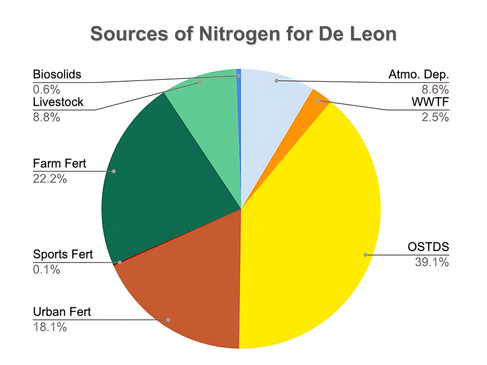Nitrate pollution sources, spring by spring.
- Brenda Wells

- Jul 10, 2024
- 2 min read
Updated: Jul 11, 2024
If we have hope of restoring Florida's springs to health (and we do have hope!) the state must have realistic plans to clean up the nitrate pollution that plagues them. To do that we must know what those sources are.

The graphs below are based on the most recent 2024 data from the Department of Environmental Protection. The first graph combines all the nitrogen source data for the 24 polluted "Outstanding Florida Springs," a designation given by the legislature to 30 of Florida's first-magnitude or culturally significant springs across the state that require restoration plans if they are found to be polluted (24 of the 30 are.)
Notes on reading these graphs
You can see at a glance if a spring is primarily plagued by agricultural runoff or by urban pollution.
Agricultural sources, like livestock waste, farm fertilizer runoff, dairies, and nurseries are in shades of green.
Pollution associated with development, like septic tanks, wastewater treatment, home fertilizers and sports fields, are in shades of yellow and orange.
WWTF = wastewater treatment facility
OSTDS = Onsite sewage treatment and disposal system - septic tanks
Atmo. Dep. = Atmospheric deposition. Some nitrogen comes from the air and rainfall
Click on a graph to enlarge it and see what's most important to address in your home springshed.

What we've learned from the 2024 data:
Agriculture is the primary source of pollution to springs statewide.
The majority of pollution to springs statewide, 76%, comes from three springsheds: The Suwannee, the Santa Fe, and the Silver/Rainbow basin.
We cannot restore Florida's springs without helping agricultural producers with the resources and programs they need to reduce pollution.
DEP's 2018 BMAPs promised to reduce nitrogen pollution in Florida's springs by 4 million pounds by 2023. Instead, it has increased by 1.5 million pounds, in part because those plans did not adequately address agricultural sources.
Required reductions at each spring
Here you can see the reduction in nitrogen measured at the spring vent that is required in each springshed to reach water quality goals. In Jackson Blue for example, levels of nitrogen measured at the spring vent must be reduced by 91% before Jackson Blue is considered restored and clean. You can see that the majority of springs must reduce nitrogen levels by at least half, a hefty challenge that will require solid and well-funded pollution reduction programs.
Nitrate sources, spring by spring
Graphs showing nitrogen sources for 14 spring basins, covering all 24 polluted Outstanding Florida Springs, are listed here in alphabetical order. Click on a chart to view it in a larger size.
Agriculture is the greatest source of nitrogen pollution to Florida's springs. How do we deal with that? Read more at https://www.floridaspringscouncil.org/single-post/agriculture-and-springs




































